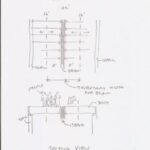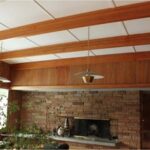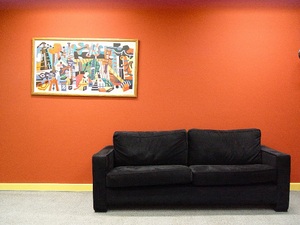Installing your joists is the next step in building a deck. The joists are what will support the deck boards. The joists run at right angles to the house. They are supported by the beam held in place with an array of nails, hangers and brackets. You need to make sure you do your homework on what is code in your area because you are required to use different hangers in different areas. For instance, if you live in a high earthquake zone, you will need to use special hangers for your joists. Joists don’t have to stop at the beam; they can extend past the beam by up to one quarter their length. Normally joists are spaced 16 inches on center when using a 5/4″ or 2″ board and laid at a 90 degree angle. If you are using some other pattern besides 90 degree you need to do some different framing, which is an article in itself.
The first things you need to install are the end joists and the header joist. The end joists are attached to the ledger and header joist with nails and corner bracing. The header joist is basically a match to the ledger board just on the front of the deck and supported by the end joists. First, rest one end joist on the beam and nail the other end to the end of the ledger. Then install the second end joist on the other side of the deck. Next cut a header joist to span the outside edges of the end joists. Get a helper to hold the header joist in place and nail it to the end joists with galvanized 10d, 3 inch nails. Measure the diagonal distance between two corners and compare the distance with the opposite diagonal. Adjust the frame until both diagonals are equal, this will ensure the deck is square. For added stability, nail angle brackets to the inside corners of the end joists and ledger and the end joists and header joist. Fasten the end joists to the beam with angle brackets and hanger nails. This should complete the instillation of the end joists and the header joist. Just make sure that the deck is square before you move on.
Next you need to hang your inner joists, first measure in from one of the end joists and mark joist locations on the ledger and on the header joist. With a combination square, draw the outline of each joist on the ledger and header joist. Align one side of each joist hanger with the joist outline and nail one side of the hanger in place with hanger nails. You don’t want to nail both sides of the hanger because if you do your joist won’t be as tight as possible in the hanger. Slip the joist in with one side nailed up and then nail the other side of the joist up. Measure the inside distance from the ledger to the header joist to find the joist length and make the appropriate cut. Position a joist in its hanger. Press the free side of the hanger tightly around the end of the joists and nail the flange to the header joist and the ledger with hanger nails. Continue along the ledger, installing one joist at a time. Attach the joists to the beam with hurricane ties or some bracing, you can also toenail the joists but the hangers work much better.
The last thing you need to do is install blocking if you feel it necessary. Blocking is basically 2x material the same depth as the joists cut to fit perpendicular to the joists. This provides some extra strength. You may also need to double up on your joists so you will have enough space to nail your deck boards down. Other than that, you are ready to move onto the next step.







